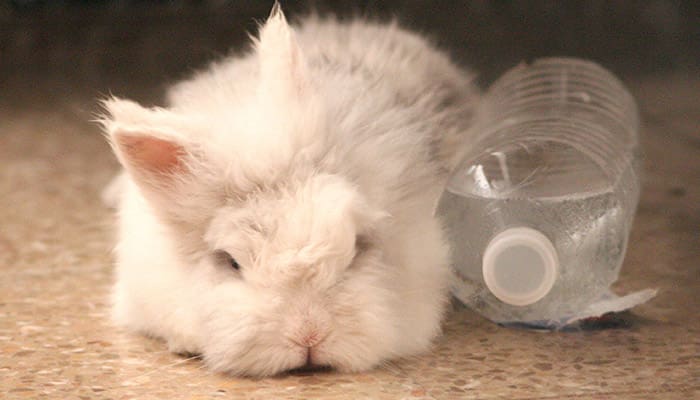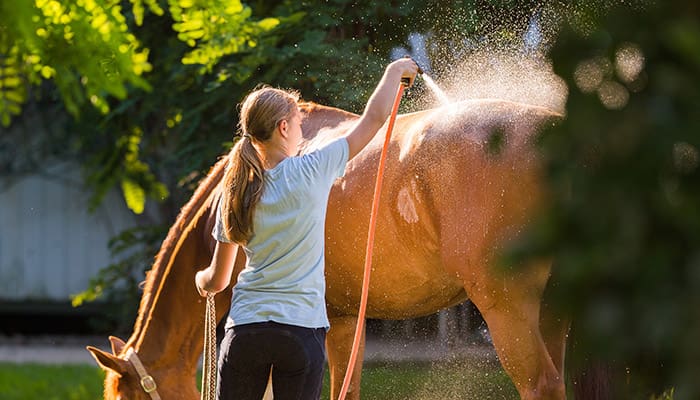What does dog insurance cover?
Discover what dog insurance can cover, from routine vet visits to emergencies and beyond.
Read more4 December 2024
Summer is such a great time to enjoy the outdoors, but we can’t forget about our furry friends! This guide has some helpful tips to keep your pets safe, cool, and healthy during the Aussie summer. We’ll chat about how to spot the signs of overheating and share some first aid tips for pets that might be dealing with heatstroke.
How can heat affect pets?
Heatstroke in dogs
Heatstroke in cats
Heatstroke in rabbits
Heatstroke in horses
How to prevent heatstroke in pets
Just like us, our pets can suffer from heat-related problems. But unlike humans, most pets don’t sweat to cool down – they rely on panting and limited sweating through their paw pads. This makes them more susceptible to overheating and heatstroke.
Heat can affect pets in different ways depending on their species, breed, age, weight, and health condition. Some pets might be more sensitive to heat than others, so it’s important to pay attention to your pet’s behaviour as temperatures rise.
While the definition of “too hot” can differ based on your pet’s breed and health, a helpful guideline is that temperatures exceeding 30°C can pose a danger, especially in direct sunlight or high humidity.
Overweight, young, elderly, giant breeds, and long-haired pets are particularly vulnerable to heatstroke. Additionally, brachycephalic breeds, such as Bulldogs and Persians, are at more of a risk due to their short noses and restricted airways.
Keep in mind that other factors such as humidity and direct sunlight can also contribute to heat-related issues, so it’s important to keep an eye on the “feels like” temperature, rather than just the actual temperature.

Heatstroke is a serious condition which can lead to seizures, organ damage and death, so it’s important to watch for signs that your pet is getting too hot.
Understanding the symptoms of overheating in pets is crucial to prevent heatstroke. Heatstroke becomes more dangerous the longer it lasts, so being aware of the early signs means your pet has a better chance of a full recovery.
Most cases of heatstroke occur when the dog has been playing or exercising, or when it’s been sitting somewhere too warm, like a car, conservatory or a room with poor ventilation.
A normal body temperature for a dog is between 38-39°C. If your dog’s body temperature goes above 40°C they are at risk of heatstroke.

Heatstroke in cats is a serious condition that can arise when they are confined in hot, poorly ventilated spaces, such as sheds, greenhouses, conservatories, or garages. Cats can’t effectively regulate their body temperature, making them particularly susceptible to overheating.
The normal body temperature for a cat falls between 38.1°C and 39.2°C. If your cat’s body temperature goes above 40°C, they may be at risk of heatstroke.

Most causes of heatstroke in rabbits are when they’re trapped in a warm place, with no shade and can’t cool down. The only way for them to lose body heat is through their skin and ears.
A typical normal body temperature for rabbits ranges from 38.5°C to 40°C. Heatstroke can occur if a rabbit’s body temperature goes above 40.5°C.

Horses are particularly vulnerable during intense exercise, as exertion generates more body heat. Environments with poor airflow, such as stables without proper ventilation, can contribute to overheating.
Normal body temperature for a horse ranges between 37-38.3°C, if your horse’s body temperature goes above 38.9°C they are at risk of heatstroke.

Prevention is always the best route when it comes to keeping your pet safe from overheating. Here are some tips for protecting your pet during hot weather:
Make sure your pet has access to plenty of clean and fresh water at all times. The constant trickle of pet water fountains can be a great way to encourage pets to drink more. Check water sources daily, especially if your pet lives outdoors.

Whether indoors or outdoors, make sure your pet has a cool and shady spot to rest in when the temperatures rise. Trees, parasols or umbrellas, large towels or tarpaulin can all provide respite from direct sunlight.
If possible, open windows and doors to allow a natural breeze to pass through the space where your pet lives. Fans are a great way to keep pets cool but just make sure they don’t become a chilly draft. Misting systems are great for horses too.
Skip, or avoid exercising your pets during the hottest times of the day. Early mornings, or evenings as the sun sets, are best.
Avoid any unnecessary travel with your pets, and never leave your pet alone in a car, even with the windows cracked. It doesn’t take long for a car to become extremely hot and dangerous for your pet.
Summer grooming is essential for keeping long-haired pets comfortable in the heat. Think about clipping their coats shorter or brushing them more frequently to remove excess fur. Both of these can help them to regulate their body temperature.
An overweight pet will find it more difficult to stay cool, so keep an eye on what they eat. Swap large meals, which can contribute to overheating, with small, frequent meals during hot spells.
By following these tips, you can help your pet stay cool, comfortable and healthy during the hot Aussie summer.
While taking preventative measures is important, accidents can still happen. In the event that your pet does suffer from heatstroke, having pet insurance can help cover the cost of expensive emergency treatment.
Heatstroke can lead to serious health complications and require emergency medical care, which can be costly. With pet insurance for cats, dogs, horses and small mammals like rabbits, you can rest assured knowing that your furry friend’s health needs will be covered in case of an emergency.
Get a pet insurance quote